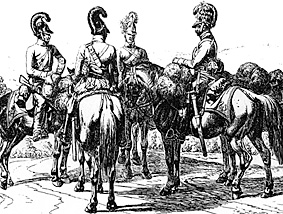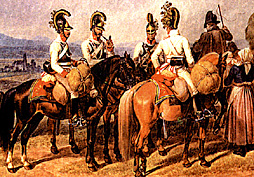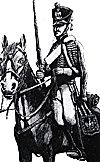Klein Plates
 Contemporary illustrations of the French armies of the Revolutionary and Napoleonic Wars are, by comparison with the amount of material available on the Allied (Coalition) armies, quite common. A fairly large proportion of French uniform plates have been and continue to be made available in the form of reprints, books, etc. [For example, Napoleon's Soldiers released by Arms and Armour Press in 1995 and
reviewed in Napoleon #1 page 34.] However, contemporary uniform illustrations of the Allies (Russia, Prussia, Austria) are so rare, and the reprints of them even rarer, that it makes this "new" collection of plates published in Germany even more welcome.
Contemporary illustrations of the French armies of the Revolutionary and Napoleonic Wars are, by comparison with the amount of material available on the Allied (Coalition) armies, quite common. A fairly large proportion of French uniform plates have been and continue to be made available in the form of reprints, books, etc. [For example, Napoleon's Soldiers released by Arms and Armour Press in 1995 and
reviewed in Napoleon #1 page 34.] However, contemporary uniform illustrations of the Allies (Russia, Prussia, Austria) are so rare, and the reprints of them even rarer, that it makes this "new" collection of plates published in Germany even more welcome.
Editionen Friese & Lacina (Haidbarg 4d, D-21244 Bucholz, Germany, fax number 01149-40-7026510) has published "The Military Paintings of Johann Adam Klein". Klein was born in Nuremberg on 25 November, 1792 and he demonstrated an artistic talent very early in life -- so much so that at the age of ten he was admitted to Nuremberg's Art School. From 1805 until 1811 he was a pupil of Ambrosius Gabler, a renowned illustrator of scientific works, and from whom Klein probably developed his penchant for observing and portraying fine detail.
In late 1811 Klein, at his father's insistence, transferred to the Viennese Academy of Art. With the exception of a brief period, Klein stayed in Vienna until after the end of the Napoleonic Wars (the period covered by this collection).
During his time in Vienna, Klein became increasingly fascinated by the life of ordinary people -- waggoners, peasants, beggars, street traders, and inevitably the soldiers who were so common a sight during the height of the Napoleonic era. In his autobiography (published in 1833) Klein wrote that the "wars of 1813 and 1814, with their encampments and columns of marching troops, provided fresh material for my sketch-books." From 1811 to 1816 Klein sketched, drew, and painted several hundred studies of the troops he saw in Austria and Nuremberg. These illustrations are almost exclusively of the soldiers of Austria, Russia, and Bavaria which are reproduced in the current reprints by Editionen Friese & Lacina.
Klein, however, should not be viewed as a "military artist" in the same way Denis Dighton or Carle Vernet are considered. He is a very talented artist who happened to use soldiers (as well as other people) for his subjects. It is because of his attention to detail that makes his work of great value to the modern uniformologist.
Most of Klein's work depicts its subjects at rest, in camp or taking a break from the march. He is weakest when striving to show movement, as in the few "battle" drawings he attempted. Klein may not have been conversant with the "dress regulations" of the various regiments, but as a student of depicting real life as accurately as possible, we can have confidence that what Klein illustrated is what he actually saw worn.
Most of Klein's work has never been published before, indeed much of it is unknown outside of a small circle of art historians since his illustrations are scattered in the collections of a dozen art galleries and museums. (Significantly, none of the Austrian soldier plates are from Vienna's Heeresgeschichtlichen Museum.) The publisher assembled Klein's numerous drawings into "sets" based on a single army regardless of the current location of the original work. While this approach may not be appreciated by art collectors, enthusiasts of Napoleonic uniforms can be eternally grateful for this method and Editionen Friese & Lacina are to be highly commended for providing us with such a useful and useable reference source.
All the plates in this series are reproduced as A4 (210mm x 297mm or approximately 8-1/4-by-11-1/4 inches) illustrations on high quality art card paper. The reverse side has the plate number, series number, and (in later sets) a brief description of the subject matter, the original's catalog number, current location, and details of the medium used, date, size, etc. In the early sets this text was provided in an accompanying booklet.
The printing is of superb quality, making each plate virtually a facsimile of the original, whether watercolor, pen and ink, or pencil sketch. Each set of plates comes in a stiff card folder with a list of contents and, except for the Russian soldiers sets, is complemented by a substantial commentary on the plates, uniforms depicted, background to the original work, etc. For example, in Austrian set number 1 this text runs an impressive 87 pages of small print, albeit repeated in German, French and English. The text for all four Russian sets is included in set number 4.
Sets currently available are --
Note: The Austrian and Bavarian sets are issued in a limited edition of 750 sets each, but the Russian sets are limited to only 300 sets each. Although by no means cheap, these sets are a great value when considering the price per plate within a set (about $6 each). Plates can not be purchased separately, only as a set.
Other than the ubiquitous Osprey series, uniform plates of the soldiers that fought against France from 1792-1815 are difficult to find. The Klein series represents the closest thing to primary material for this period, and are highly recommended.
At left, officer of 10th Hussars.
Full color ink jet reproductions of the original 48 color plates are now available for $33 US (price includes postage) from Historical Miniature Art and Review Quarterly, P.O. Box 9703, Fort Worth, TX 76147 USA, phone 817-626-0586. The text is being translated and will be offered in the future.
HMA&RQ is a three-year-old publication that has added some attractive format changes recently. It now includes a significant number of articles and color pictures of Napoleonic subjects, in addition to the other historical periods covered by the magazine. A sample copy is $5.95 US, one year subscription of four issues $21.95 US (price includes postage).
Richard F. Driessen, an American artist who is interested in the Napoleonic period, sent samples of his original black and white illustrations. Done in a "daguerreotype" style (early photographic prints made on a silvered copper plate, after L. J. M. Daguerre, 1789-1851, the French inventor), prices for tinted photographs of these drawings can be obtained by writing to Richard F. Driessen, 9121 Vena Avenue, Arleta, CA 91331 USA, phone 818-364-3417.
This article appears in MagWeb (Magazine Web) on the Internet World Wide Web. At right, one of Klein's colour illustrations, done from 1811-1816, of soldiers he saw while living in Vienna and Bavaria. These reproductions are done on high quality art card paper with accompanying text in German, French, and English.
At right, one of Klein's colour illustrations, done from 1811-1816, of soldiers he saw while living in Vienna and Bavaria. These reproductions are done on high quality art card paper with accompanying text in German, French, and English.
Austrian Soldiers, part 1: 31 color and 8 black and white plates, plus text. $220 US
Bavarian Soldiers, part 1: 20 color and 6 black and white plates, plus text. $173 US
Austrian & Bavarian Soldiers, part 2: 8 color and 18 black and white plates, plus text. $146 US
Russian Soldiers, parts 1 through 3: 8 color and 8 black and white plates per set, no text. $96 US
Russian Soldiers, part 4: 8 color and 8 black and white plates, plus text for all four sets. $96 US
Chelminski Plates
 In 1913, a book on the Duchy of Warsaw, called L'Armee du Duche de Varsovie, was published in Paris. It included nearly 60 color and black and white illustrations of Polish soldiers who served under Napoleon, done by J. V. Chelminski, with accompanying text by Commandant A. Malibran.
In 1913, a book on the Duchy of Warsaw, called L'Armee du Duche de Varsovie, was published in Paris. It included nearly 60 color and black and white illustrations of Polish soldiers who served under Napoleon, done by J. V. Chelminski, with accompanying text by Commandant A. Malibran.
Driessen Plates
 At right, one of the "daguerreotype" style original black and white illustrations.
At right, one of the "daguerreotype" style original black and white illustrations.
Back to Table of Contents -- Napoleon #6
© Copyright 1996 by Emperor's Press.
The full text and graphics from other military history magazines and gaming magazines are available at http://www.magweb.com